|
The cave monastery:
Ridi Vihara, an explorerís dream come true
by Nilma DOLE
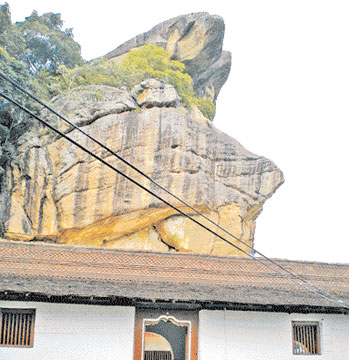 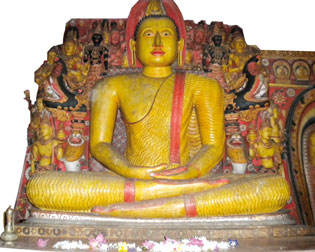 For
any discerning adventurer, exploring obscure historical sites around Sri
Lanka can be a daunting task. It isn't easy because one can lose one's
bearings, making the whole sojourn quite a tester. However, once you get
to your destination, you find how truly magical it is and how privileged
we are to be Sri Lankans with such a rich heritage. For
any discerning adventurer, exploring obscure historical sites around Sri
Lanka can be a daunting task. It isn't easy because one can lose one's
bearings, making the whole sojourn quite a tester. However, once you get
to your destination, you find how truly magical it is and how privileged
we are to be Sri Lankans with such a rich heritage.
One such wonder is the glorious silver temple, the Ridi Vihara. Even
though the journey is through many hidden gravel roads and winding
bends, this amazing place is shrouded in mystery. Moreover, it is indeed
peaceful to discover the place for yourself without the hustle and
bustle of vendors pushing their wares in your face, buses honking their
horns or even hordes of tourists because it's difficult to access.
A lesser known site close to Kurunegala, Ridi Vihara is actually a
cave monastery and it offers the same feeling even today.
Ridi Vihara is located in close proximity to the quaint town of
Ridigama (silver village) which is 15 kilometres west of the
Kandy-Dambulla highway, roughly parallel between Matale and Kurunegala.
What would be surprising to note is that Ridi Vihara was actually
built during the reign of King Dutugemunu (164 - 140 BC). According to
legend, the king was building his prized creation, the Ruwanweliseya
Dagaba when he suddenly ran out of funds. So it was like a gift from the
gods when he discovered rich silver ore in Ridigama and built the Ridi
Vihara in appreciation. Unfortunately, King Dutugemunu didn't live to
see Ruwanweliseya completed so it was just as well that the great leader
at least got to witness the Ridi Vihara in all its glory.
South Indian art
At the entrance to the walkway, you can see the Varaka Valandu Vihara
(famously known as the jakfruit temple) which is on a fork leading to
the historical sites. Built in the 11th century BC, the Varaka Vihara is
greatly influenced by South Indian art where there are sculptures and
Kandyan styled paintings showing unity in diversity.
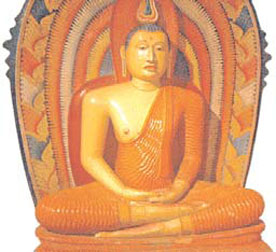
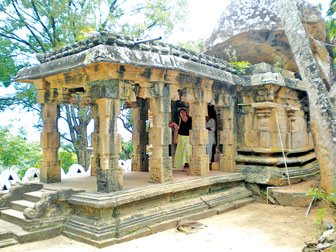 |
|
The Varaka Valandu
Vihara |
Turning left and walking further along, a set of wooden pillars
exists leading to a little rock outcrop, rather like a mini Sigiriya,
where the lower temple or 'Pahala Vihara' lies. Just like Sigiriya's
troublesome wasps (hornets), you have to be careful as there hangs a
huge beehive so it's best to tread quietly as a commotion might cause
them to stir.
It might take some convincing powers to get the caretakers to open
the little cave temple which is amazing once revealed. Like something
out of Ali Baba's story, you are greeted by a Pancha Nari Gataya (knot
of five maidens) at the entrance and inside, a resting Buddha statue
encased in gold can be seen. Moreover, at the base of the statue, you
can see Dutch tiles depicting Biblical scenes donated by a Dutch
bhikkhu. Further along the cave are the illustrious sculptures of
Avalokiteshvara (Natha), King Dutugemunu, of which the latter is an
antique statue dating from the Anuradhapura period, as well as a
fascinating reclining Buddha statue from Burma. The lovely ivory carving
of a vase brilliantly fitted in to give the cave a subtle look is
another attraction.
Upper, lower temples
The Upper Temple or Uda Vihara is right behind the Lower temple which
is an 18th century structure constructed in memory of King Kirthi Sri
Rajasinghe. A beautiful moonstone can be seen along with images of
elephants, various Hindu deities and Buddha statues which goes to show
that different beliefs can co-exist in peace and harmony.
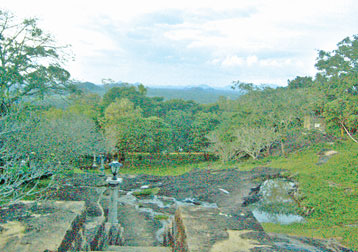 |
|
The view from the
temple |
 |
|
The painted optical
illusion |
The Buddha statue is flanked by a Makara Torana (Dragon Arch) of
images of gods, devotees and Buddhas. Paintings of mythological animals
and King Rawana too adorn the temple.
One of the most popular images at Ridi Vihara is a 'trompe l' oeil'
or a painted optical illusion at the Cobra House, next to the main
chamber of the Upper Temple. A wonderful painting of nine Kandyan
maidens perfectly fuse to form an elephant which leave visitors in
amazement at the talent and creativity by artisans from years ago.
There is also a man-made lake near the foot of the hills. Walk up
some precariously - cut stone steps to see an abandoned Dagaba at the
top of a smooth rocky outcrop. On the way up, to right is an ancient
inscription in the stone that has been etched as testament to King
Dutugemunu's life.
Ridi Vihara is one of those hidden gems that are quite a challenge to
visit, but it's always the wonder and talent exhibited by our
predecessors that reveal that art definitely runs through our veins.
|

